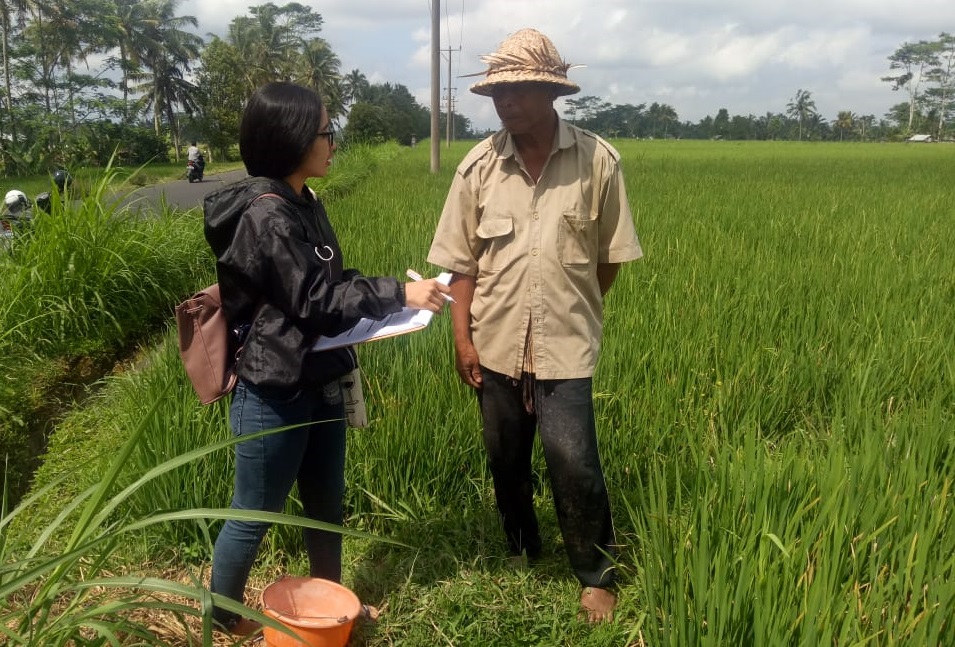Agricultural Insurance: will farmers pay a premium?
30/06/2020 Views : 1205
I Wayan Budiasa
Agricultural Insurance:
will farmers pay a premium?
Dr. I Wayan Budiasa, SP, MP

Photo: A CVM survey by a enumerator in Subak Bambang Let, Bangli
Agricultural
Insurance in Several Other Countries
India has known agricultural insurance since
1972 and the adoption of massive agricultural insurance began in 1985 with a Comprehensive
Crop Insurance Scheme. Agricultural insurance premiums in India of 50% are paid
by the central government and 50% are borne by the provincial and state
governments.
China has implemented agricultural insurance
since 1982 through livestock and crop insurance. Agricultural insurance in
China is voluntary and the burden of insurance premiums is borne by three
parties, namely the central government and local governments through subsidies,
and the rest is borne by farmers. The amount of insurance premium subsidies
ranges from 20% to 100% depending on the conditions of each region.
Agriculture in Vietnam accounts for 22% of Gross
Domestic Product. However, Vietnamese agriculture is often hit by whirlwinds,
floods, droughts, and storm surges. Agricultural insurance in Vietnam started
in 1982 on a voluntary basis without premium subsidies from the government.
Agricultural insurance products covered by insurance companies include corn,
cassava and rice.
Agricultural insurance in Thailand was carried
out in the period 1978-1990. The insurance is closed until 2005 due to losses
and the amount of administrative costs borne by the executor of insurance. In
2006-2010 Thailand developed agricultural insurance based on a voluntary
climate index without subsidies with premium rates above 10%. Next, Thailand applies
three types of subsidized insurance premiums, namely poor farmer households
receiving 90-100% premium subsidies, other farmers 60-70%, and agricultural
production organizations subsidized insurance premiums by 50%.
Japan started livestock insurance in 1929 and national
forest insurance in 1937. Furthermore, Japan developed 5 types of insurance
namely (1) rice, wheat, barley insurance (mandatory), (2) livestock insurance
(mandatory), (3) fruit product insurance and fruit crops (voluntary), (4) field
crop insurance and various plants (voluntary), and (5) greenhouse insurance
(voluntary). The agricultural insurance scheme in Japan is based on solidarity
between farmers, relying on a network of agricultural cooperatives at the
local, regional and 300 national-level agricultural cooperatives.
Agricultural Insurance in Indonesia
The agricultural insurance
program in Indonesia is mandated by Law Number 19 of 2013 concerning the protection
and empowerment of farmers. The law requires the central government and
regional governments to provide protection to farmers against losses from crop
failures. The implementation of the law legally began in 2015 with the issuance
of Minister of Agriculture Regulation Number 40 of 2015 concerning agricultural
insurance facilitation. As a form of law implementation, the government through
the Ministry of Agriculture and the Ministry of Finance have established the
agricultural insurance program as a national food security program. The
agricultural insurance program began to be widely applied in 2015 in
collaboration with PT. Asuransi Jasa Indonesia (Jasindo) appointed as the
executor of the Rice Farming Insurance (RFI) program with a target of 1,000,000
ha of rice farming per year. The object of coverage that will be borne by Jasindo
is the paddy fields cultivated by the cultivating farmers from a group of
farmers (the insured). Each insured gets one insurance policy with an overview
containing the insurance coverage data of its members. The period of time used
in insurance is one planting season starting from planting to harvest. The
insurance price is IDR 6,000,000 per hectare with a premium of IDR 180,000 per
hectare. The central government provides a premium subsidy of 80% (Rp144,000),
while a 20% premium (Rp36,000) is paid by farmers. In some areas of the
Province of Bali, the insurance premium of 20% is subsidized by the local
government or by a private company through a CSR scheme such as by PT Setia
Tani.
Willingness of Farmers to Pay RFI Premiums
Based on the results of research by I Wayan Budiasa, I Gede Rai Maya Temaja, I Nyoman Gede Ustriyana, I Wayan Nuarsa, and I Gusti Bagus Adi Wijaya of 270 RFI participant farmers in 9 subaks scattered throughout Regencies or Cities in Bali Province for the application of RFI from October 2015 to September 2017 covering an area of 43,955 hectares, apparently farmers were willing to pay an RFI premium of Rp61,281.57/ha/season (34.05% of the price of the full premium). Based on the results of the study, the amount of AUTP premium that can be charged to farmers in the Province of Bali is Rp. 60,000/ha/season so that the AUTP premium subsidy from the government can be reduced to Rp120,000/ha/season. The results of the study were published in the June 2020 issue of ISSAAS Journal entitled The Willingness of Farmers to Pay Insurance Premiums for Sustainable Rice Farming in Bali (http://issaasphil.org/wp-content/uploads/2020/06/6.-Budiasa-et-al.-2020.-Rice-Insurance-Bali-FINAL.pdf).
